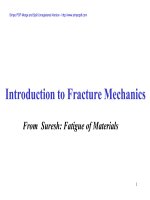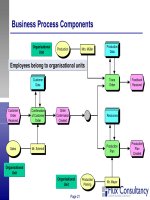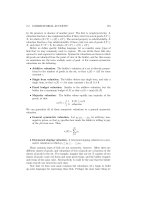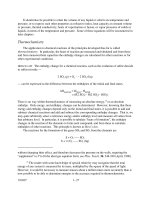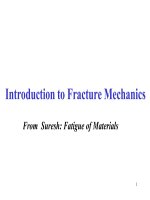Introduction to Fracture Mechanics phần 3 docx
Bạn đang xem bản rút gọn của tài liệu. Xem và tải ngay bản đầy đủ của tài liệu tại đây (205.9 KB, 10 trang )
Plane Crack Problem
Airy Stress Function
For the plane problem, the equations of equilibrium are
satisfied when the stress components are expressed by
the
Airy stress function through
x
,
,
11
22
xxx
rr
21
,
,
222
r
r
rr
rr
.
1
x
rr
r
Using these definitions for the stresses and Hooke’s
law, the strains can be expressed in terms of .
x
It can be shown that the compatibility equation, when
expressed in terms of the Airy stress function, satisfies
the biharmonic equation:
.
11
,0
2
2
22
2
222
rrrr
The boundary conditions for this plane crack problem
22
The boundary conditions for this plane crack problem
are: for
0
r
.
These conditions express the fact that the crack is
traction-free (no loads applied to crack face).
Note: there is no condition on .
rr
A choice of the Airy stress function for the present
crack problem should be such that
x has a singularity
at the crack tip, and is single-valued. We try a solution
of the form:
,,,
2
rqrpr
23
Where p and p are harmonic functions of r and θ
(i.e. and
0
2
p
).0
2
q
Now consider a separate solution, of
the following form (Williams, 1957):
,
rR
,sincos
21
rArAp
.2sin2cos
2
2
2
1
rBrBq
This form leads to the following expression for x:
2coscos
11
2
BArx
.
2
sin
sin
2
B
A
r
24
.
2
sin
sin
22
2
B
A
r
Note that we have expressed x as a symmetric part and
an anti-symmetric part. The symmetric part provides
the
Mode I solution while the anti-symmetric part
provides the
Mode II solution. We will derive the
Mode I solution here.
2
2
r
2coscos12
11
BAr
rx
rr
r
1
25
2sin2sin1
11
BAr
Apply the boundary conditions:
,0cos
11
BA
.0sin2
11
BA
The admissible cases are: (i) cos λ π = 0,
hence
where Z is an integer including zero, and thus
B
1
= A
1
λ /(λ + 2) or (ii) sin λπ = 0 and hence λ = Z and
B
1
= A
1
. Since the governing equations are linear, any
linear combination of the admissible solutions provides
a solution, hence
λ
can have any satisfying:
2
12
Z
26
a solution, hence
λ
can have any satisfying:
,
2
Z
Where Z is a positive or negative integer, including zero.
Out of all the possible values of λ, how do we decide
the appropriate value of
λ?
The value of
λ cannot be found from any mathematical
argument. We need to use a physical, based on the total
strain energy around the crack tip. From the expressions
for the stresses, and Therefore the
r
~
.
~
r
27
for the stresses, and Therefore the
strain energy density is given by
r
ij
~
.
~
r
ij
.~
2
1
2
r
ijij
The total strain energy within an annular region,with
inner and outer radii
r
0
and R, respectively, centered at
the crack tip, with unit thickness is
.~
2
1
00
12
2
0
2
0
drdrrdrd
R
r
ijij
R
r
28
We assert that the strain energy should be bounded
(Φ < ∞) as r
0
0. Using this physical argument, we
see that λ > -1. (λ = 1 gives ). If λ < 1, the
strain energy will not be bounded.
0
ij
2
Thus the physically admissible values of λ are
,
2
)( ,,2,
2
3
,1,
2
1
,0,
2
1
Z
or
where Z is –1, 0, or a positive integer. Taking the most
dominant singular term (λ = 1/2 and thus B
1
=A
1
/3)
we find that:
29
we find that:
2
5
2
1
2
3
2
3
cos
3
1
2
cos
rrAr
~
2/10
2
1
1
rrrA
ijij
I
ijij
The higher order terms, with exponents greater than
zero, vanish as r
0. We write where
K
I
is the stress intensity factor.
Thus we have that:
2/
1 I
KA
.
~
2
jxix
I
ij
I
ij
r
K
30
The first term is the leading singular term for linear elastic
mode I crack problems. is a function of
θ alone (no r
dependence). The second term, generally referred to as the
‘
T term’, is a non-singular term which can be important in
some situations involving fatigue. is the Kronecker
delta function.
I
ij
~
ij

